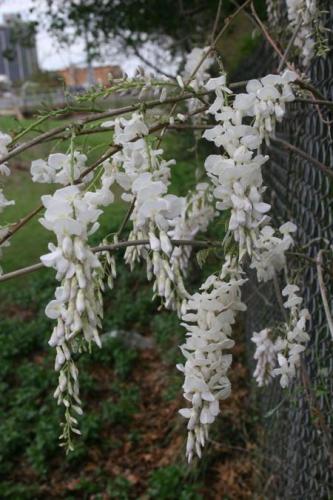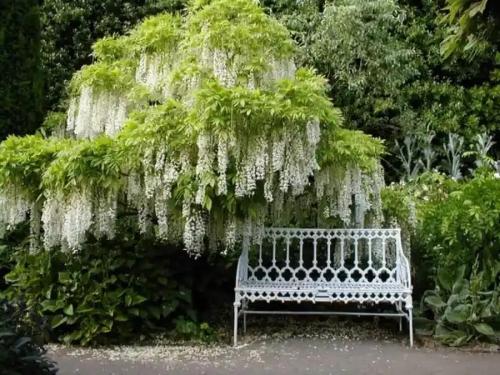... in the early 1830's.
And although the true reasons may never be known, it was Chinese wisteria that spread its tendrils most successfully. White Japanese wisteria was not only hard to see in gardens, it was almost impossible to find in the trade. And it stayed that way for decades.
Fortunately, a few cutting edge growers [like Iseli Nursery in Boring, Oregon] began to introduce American gardeners to what has been a long overlooked ornamental vine.
Donald Wyman, the Head of Horticulture at Harvard University's Arnold Arboretum from 1935 to 1970... was undoubtedly one of those who championed the white Japanese wisteria. In his 1948 Shrubs & Vines for American Gardens he pointed out that, "The varieties noted for their delicious fragrance belong mostly to the species floribunda or its hybrid 'formosa'. The true Chinese wisteria has little fragrance..."
Here are a few more examples of the Japanese form...................................




In this same book, he recommends a treatment for a wisteria vine that has not bloomed in the past. He says,
"The vegetative growth should be retarded, either by a continual cutting back of the elongated shoots in the late spring or early summer or by root pruning. If these fail, then a ditch around the plant might be dug 1.5 feet deep and several feet from its base depending on its size. Superphosphate could be mixed with the soil as it is thrown back into the ditch, several pounds for each inch in diameter of the trunk. The combined root pruning and application of superphosphate has helped both wisterias and flowering dogwoods in producing blooms."
One other aspect of growing wisteria needs to be addressed... and that is the support structure it will grow on. DO NOT make the mistake of creating a support system that will not support an increasingly heavy collection of vines.
Fassaden Grun is a German company that specializes, "... in facade greening ~ transforming facades into living walls with climbing plants and the trellises to support them. We sell wire rope systems made of high-grade stainless steel, the climbing plants themselves, and fixtures for metal, wood, and bamboo trellises."
Their comments on support structures for wisteria are definitely worth reading,
" Wisteria needs sturdy, preferably rod-like support systems, designed for the anticipated height and width of the plant. A simple linear system, rather than one that coves a large surface area; no wooden trellises. Wire ropes are suitable if the main trunk is trained strictly parallel to the wires, without twining, as illustrated in the photos. The short side branches are to be arranged so that any scratching of the wall is prevented should windy conditions make them move or twist the spindles. Lightning conductors, downpipes, and eave gutters, etc.. are not to be reached by the plant; all growth supports should have a distance of 2 meter's from any such building elements and to the eave gutters-- to the sides as well as from the top. For suitable cable systems, see below. Use heavy or massive systems only; with potted plants or for wisteria frutescens, easy or medium systems will be adequate."
Incidentally, Wyman [way back in 1947] was able to list 10 specific varieties of Japanese wisteria available in several colors. Some of them might still be available.



